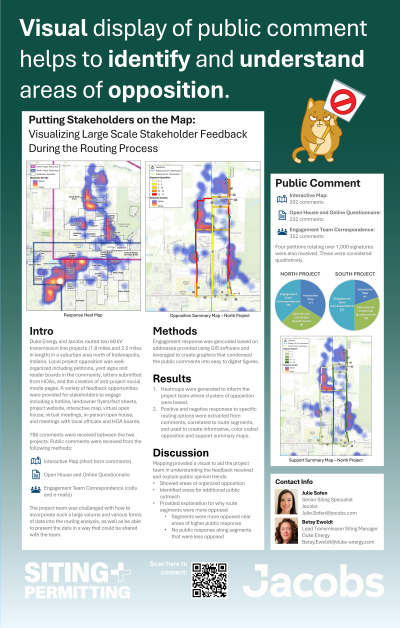Putting Stakeholders on the Map: Visualizing Large Scale Stakeholder Feedback During the Routing Process

.jpg)
Julie Sofen (she/her/hers)
Senior Siting Specialist
Jacobs, Wisconsin
Poster Presenter(s)
Stakeholder feedback is critical to successfully routing a new transmission line in a densely developed area. How is that feedback incorporated into the routing process when you have high public interest? How do you ensure that you track all feedback, apply the data to your routing process, and effectively incorporate feedback into the final routing decision?
Duke Energy and Jacobs Engineering operated at the intersection of siting and engagement to route two controversial projects north of Indianapolis, Indiana. Local project opposition was well-organized and included 1,000+ signature petitions against the projects, yard signs and reader boards in the community, letters submitted from HOAs, and the creation of anti-project social media pages. Duke Energy developed a variety of feedback opportunities for stakeholders to engage, including a hotline, landowner flyers/fact sheets, project website, virtual open houses, virtual meetings, in-person open houses, and meetings with local officials and HOA boards.
Given that consideration to stakeholder feedback is an important step in the routing process, the project team was challenged with how to incorporate such a large volume and various forms of data into the analysis, as well as be able to present the data in a way that could be shared with the team in a meaningful way.
Engagement response was geocoded using GIS software and leveraged to create graphics that condensed hundreds of public comments into easy to digest figures. Heatmaps were generated to inform the team where clusters of opposition were based and identify areas for added public outreach. Positive and negative responses to specific routing options were extracted from comments, correlated to route segments, and used to create informative, color coded support and opposition summary maps. These analyses explained public opinion trends to members of the greater project team.
